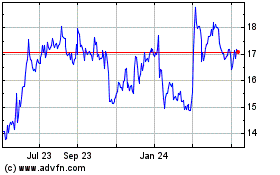Ranks of Women CEOs Shrink -- WSJ
May 24 2018 - 3:02AM
Dow Jones News
Females are leaving at same rate as men, but some high-profile
departures stand out
By Vanessa Fuhrmans
This article is being republished as part of our daily
reproduction of WSJ.com articles that also appeared in the U.S.
print edition of The Wall Street Journal (May 24, 2018).
If it seems like several female CEOs have lost or left their
jobs lately, it is because they have. But so, too, have many male
chief executives. So why do the women's departures seem so
conspicuous?
One reason is there are so few females at the helm of major
corporations to begin with. One year ago, a record 32 women were
running Fortune 500 firms. Today that number is 24.
The high-profile exits of a handful of women leaders in recent
months -- including Campbell Soup Co.'s Denise Morrison last week
and Mattel Inc.'s Margo Georgiadis in April -- appear to have
dramatically altered the C-suite's gender landscape. Other women
who have recently left the corner office include Mondelez
International Inc.'s Irene Rosenfeld, Staples Inc.'s Shira Goodman
and Hewlett Packard Enterprise Co.'s Meg Whitman, who as eBay
Inc.'s former chief has run two Fortune 500 firms. But women aren't
leaving or getting pushed out of CEO positions in greater
percentages than men, according to Equilar, a research firm that
tracks executive hiring and firing.
At the 500 largest publicly traded firms, female CEOs have
departed at roughly the same rate as their male counterparts since
the beginning of 2017, Equilar data show. Recent high-profile male
CEO exits include Steve Wynn from his casino company, Mark Fields
from Ford Motor Co., Jeff Immelt from General Electric Co. and
Richard Smith from Equifax Inc.
Significantly changing the absolute figures of women in the near
term will be tough, say CEO recruiters and business leaders. Many
companies haven't sufficiently stocked the pipeline with potential
women leaders to bolster their ranks in any consistent way, let
alone replace departing female CEOs with other women.
"As long as we have these fortuitous [women-CEO] appointments
instead of a real gender pipeline being built as a regular course
of business, the numbers are going to be volatile," said Jane
Stevenson, head of the global CEO succession practice for
Korn/Ferry International, an executive recruitment firm.
In the past five years, data from executive-recruiting firm
Spencer Stuart show only one female chief at an S&P 500 company
was succeeded by another woman: Debra Crew succeeded Susan Cameron
as head of tobacco giant Reynolds American Inc. in January 2017.
Ms. Crew left in December not long after British American Tobacco
PLC acquired the company.
In the C-suite, women hold only about 20% of executive jobs,
according to data compiled from 222 major companies last year by
LeanIn.Org and McKinsey & Co. Many senior women are also in
roles that don't have a direct impact on the bottom line, such as
overseeing legal departments, rather than operational roles with
profit-and-loss responsibilities, which is the typical path to
becoming a CEO.
Ms. Stevenson said the CEO-succession plan of a company she met
with a couple weeks ago illustrates the point. Two senior
executives -- a man and a woman -- are candidates to one day
succeed the current boss. The woman has broad experience across the
business, but has never been promoted to a role with
profit-and-loss responsibility. The man, on the other hand, has had
such posts.
"If they don't afford the woman a P&L role soon, what are
the real chances they will pick her when the time comes?" Ms.
Stevenson said, adding that getting more women into the CEO slot is
like working a chessboard. "You have to set up the moves to be able
to make the moves."
Some research suggests that once women do get to the top, it can
be difficult to hold on to the perch. Studying the tenures of the
50 women who led Fortune 500 companies before 2015, researchers at
Utah State University found that women were more likely to be
appointed as CEO at a company in crisis than men, increasing the
odds of a rocky tenure.
One reason may be that with so few CEO possibilities offered to
women, they may be more likely to seize an opportunity their male
counterparts might shun, said Donald Hambrick, a professor of
management at Penn State University's Smeal College of
Business.
Ms. Georgiadis, a former Google executive, took the helm of
Mattel as the toy maker was in a protracted sales slump and
struggling with adapting to a more digitally focused consumer base.
She left after a year, succeeded by Ynon Kreiz, the former head of
Walt Disney Co.'s Maker Studios. At the time, Ms. Georgiadis told
shareholders, "It has been a privilege to lead such an iconic
company at an important time for change."
Jewelle Bickford, a partner at Evercore Wealth Management who
helps lead "Paradigm for Parity," a coalition of business leaders
who have pledged to speed women's progress up the corporate ladder,
said many companies that have put women at the helm are older
legacy companies grappling with technological disruption in their
industries.
"These are companies under pressure in the world we live in
today, whether they are led by men or women," she said.
Write to Vanessa Fuhrmans at vanessa.fuhrmans@wsj.com
(END) Dow Jones Newswires
May 24, 2018 02:47 ET (06:47 GMT)
Copyright (c) 2018 Dow Jones & Company, Inc.
Hewlett Packard Enterprise (NYSE:HPE)
Historical Stock Chart
From Mar 2024 to Apr 2024

Hewlett Packard Enterprise (NYSE:HPE)
Historical Stock Chart
From Apr 2023 to Apr 2024
